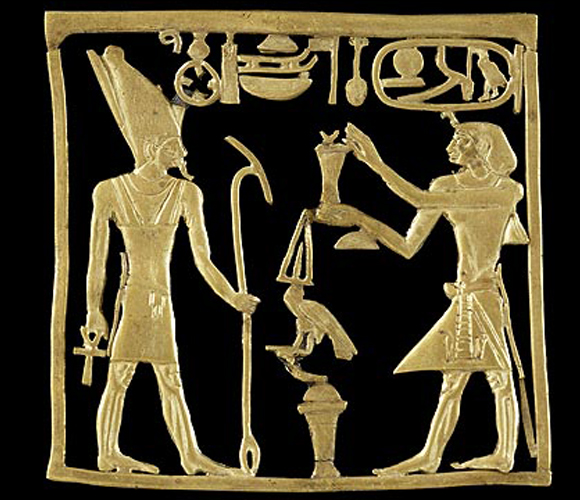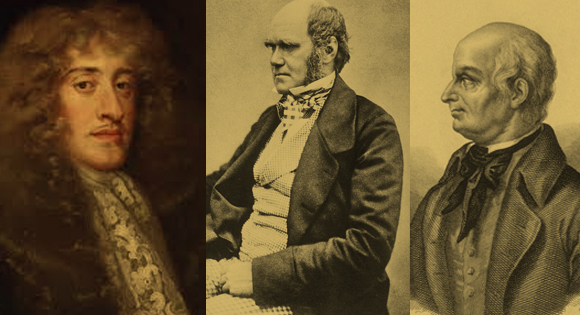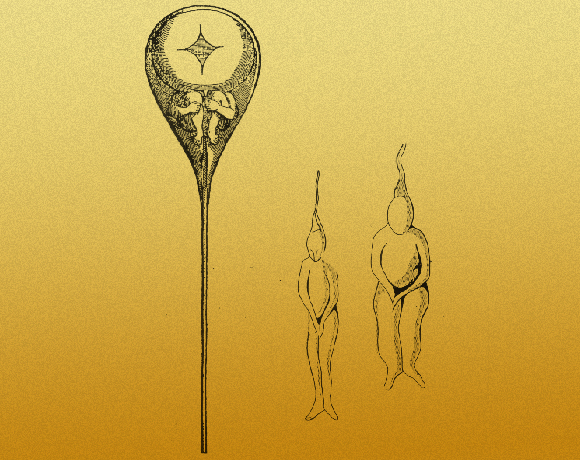Sperm cells harbor whole fetuses that have sperm cells of their own; the objects moving inside semen are parasites unrelated to reproduction; semen turns menstrual blood into a fetus or breastmilk – these are only some of the myths related to pregnancy and childbirth that were accepted until only recently. How were they born and who disproved them?
The connection between sexual intercourse and pregnancy or childbirth seems obvious enough to us, but is it really so trivial? When, for example, we suffer a blow, we feel pain; when hungry, we eat and the hunger is relieved – in these cases the link between the cause and the effect is easily comprehensible, since the effect takes place immediately or shortly after the cause. Sexual intercourse, however, does not always lead to pregnancy, and even when it does, it takes several weeks to recognize the first signs.
So when did humans learn that pregnancy follows sexual intercourse? Since it is rather difficult to learn about people's convictions and thoughts from fossil records, there is no conclusive answer to this question. We can only hypothesize what cognitive abilities are required for connecting the two: abstract thinking, complex understanding of cause and effect, memory, and possibly, also an ability to plan and foresee the future. But this only leads us to additional questions that are similarly challenging.
Does the design and manufacture of stone tools, which requires deliberate planning, provide evidence for the presence of such capabilities? If it does, then they had existed as early as three million years ago, at least in individuals from the Homo habilis species, if not earlier. Do abstract paintings indicate sufficiently conceptual and sophisticated thinking? The oldest painting that we know of dates back to 73 thousand years ago.
No mating – no agriculture
Ultimately, the honest answer is that we do not know when that eureka moment took place, and we will probably never know. We can, however, determine an upper bound for this moment. About 10-11 thousand years ago, as humans made their first steps in animal husbandry with sheep and goats, they had probably already known that it takes both a male and a female to obtain additional sheep and goats – and if they did not know, the better farmers among them probably caught on quickly.
References to the role of males in the formation of life are already present in the most ancient mythologies that left physical remains. The Egyptian deity Atum, for instance, created the god of air, Shu, and the goddess of moisture, Tefnut, from his sperm. According to some versions, he had both male and female parts, so he could have children without requiring a partner. Shu and Tefnut gave birth to the god of the earth, and the goddess of the sky, who then gave birth to other gods, always in male-female pairs.
In the historic period, from which there are also written records, there was no longer any doubt as to the role of men in reproduction. One of the earliest known written documents is the Code of Hammurabi, inscribed in the 18th century B.C., which contains numerous references to the obligations of fathers towards their children and of children towards their fathers. The biblical commandment “be fruitful and multiply” (pru u’rvu) addresses both men and women, and Noah made sure to board pairs of male and female onto the arc.
The earliest reference to pregnancy and its duration is probably the Roman code of law from the 5th century B.C., the Laws of the Twelve Tables. Table IV states that "a child born after ten months since the father's death will not be admitted into a legal inheritance." Did the Ancient Romans think that pregnancy takes ten months? Possibly, but it is more reasonable to assume that they added the tenth month for exceptional cases, recognizing that some pregnancies take longer than others.
Is there any human civilization existing today, or in the last few hundred years, that failed to make the connection between sexual intercourse and childbirth? Probably not. Anthropologists working in the late 19th and early 20th centuries reported on societies, such as the people of Papua New Guinea, that were not previously exposed to other civilizations, and did not know about the male’s role in creating new life, but their claims were later disproven. The people of these islands did, in fact, recognize that sperm has an important role: as they described it to the anthropologist, its role is to cause menstrual blood to clot, and this creates a baby.

A gold relief from the 18th century B.C. of the Fourth Pharaoh giving his offering to the god Atum, on display at the Great North Museum | Photograph: The British Museum
Canals out of the womb and frogs in pants
To us, of course, this explanation may sound a little strange, if not silly. The residents of those islands evidently know nothing about embryonic development, as do Western scientists, who have studied and revealed at least the basic principles of that development hundreds or even thousands of years ago. Right?
Well, not exactly. The full answer to the question – "where do babies come from?" –began unraveling only in the 19th century, surprisingly late. Previously, scientists offered many conjectures, some even stranger than the clotted blood theory.
Aristotle thought that the mother's main role was providing food for the fetus, and that the father was the one who provided the force of creation needed for its development. Therefore, the most "natural" or desired course of events is the birth of a boy who resembles his father. The birth of a girl indicates a failure of the natural process. Aristotle wrote that "for the principle of movement, i.e. the male, is the best and most divine thing for beings who are born, while the female is the matter." Galen, a famous second century A.D. physician in the Roman Empire also viewed the male sperm as the main power of creation, but also consigned a role to the mother in embryogenesis, albeit a secondary one.
Renaissance scientists took interest in anatomy, conducting anatomical studies and performing autopsies. However, they came to very limited conclusions over the years, and were often subject to misleading bias. For instance, when Leonardo da Vinci drew the internal organs of a pregnant woman, he included a canal leading from the uterus to the nipple. These types of canals do not exist in reality, and are taken from a theory proposed by a number of Greek philosophers, stating that milk is actually transformed menstrual blood. They also had evidence to support this theory: while a woman is pregnant or breastfeeding, she does not menstruate. Where did the blood go? It turned into milk!
Towards the end of the 17th century, an experiment conducted by Italian biologist Lazzaro Spallanzani conclusively showed that semen was indeed necessary for creating a fetus (and was also one of the strangest biological experiments ever conducted). Spallanzani decided to test this by using frogs. He created the first-ever frog contraceptive, by dressing the males in tight silk pants. The males courted the females, performing all motions required for mating, but their efforts did not result is a single tadpole. Then Spallanzani took the pants and collected the semen from them and performed what was probably the first artificial insemination in frogs. It worked – the tadpoles hatched and the semen’s key role in reproduction was never doubted again.

Scientific breakthroughs – and misconceptions – in understanding reproductive processes. From the right: Spallanzani, Darwin, van Leeuwenhoek | Source: Wikipedia
Sperm cells or parasites?
What in the seminal fluid is so essential for creating an embryo? The answer to this question became increasingly apparent with the invention of the microscope, but once again, science seemed to be moving one step forward and then, quickly, two steps back. In 1677, Antonie van Leeuwenhoek, one of the pioneers of microscopy, used his novel invention to examine his own semen, and was surprised to see "so great a number of living animalcules [so he called the tiny creatures he saw through the microscope] in it, that sometimes more than a thousand were moving about in an amount of material the size of a grain of sand."
Van Leeuwenhoek was so excited with the discovery that he quickly wrote about his findings to the Royal Society. But soon he would conclude that those tiny creatures have nothing to do with reproduction, and that they simply live inside semen – just as similar creatures were found to inhabit water, the material scratched off his teeth, and even between his toes.
This "parasite hypothesis" was sustained, at least in some circles, until the 19th century. The theory that followed and claimed that each of these little creatures was a sperm cell, containing all the material required to make new life, met with resistance: if this is so, asked supporters of van Leeuwenhoek’s hypothesis, then why are there so many of them? One would have been enough! God would not possibly have created such a wasteful mechanism.
A fetus within a fetus within a fetus
Another, highly popular, theory until the mid-19th century was preformationism, according to which embryos are not created at all, but already exist perfectly inside the mother's eggs, and during pregnancy, they “spread” and grow. And, of course, each female embryo inside the eggs has its own eggs, with even smaller embryos, containing eggs with even tinier embryos, and so on and on, like an infinite line of Russian nesting dolls, till the end of time.
According to this theory, the sperm was only responsible for kick-starting the growth process, with no actual effect on embryonic development. After sperm cells were discovered and at least a part of the scientific community accepted the fact that it was not parasites living in the semen, other scientists claimed that those little people are actually encased inside the sperm and not the egg. This theory was a throw-back to the hypotheses of the Ancient Greek, whereby the force creating the embryo originates entirely in the male, and the female is only responsible for providing food and a place for it to grow until birth, but not much more than that.

On the right track
Ultimately, more research, the lack of evidence for the presence of tiny embryos in sperm or eggs, and the simple fact that a child usually presents characteristics of both parents, led most scientists to conclude that the embryo is created from a combination of materials from both. However, it was still unclear what these materials actually were. In the 19th century, Charles Darwin developed the pangenesis theory, according to which cells constantly secrete "particles of inheritance", which he termed gemmules, that represent the traits of different organs. Some of these gemmules cluster in reproductive organs, and during fertilization, merge with the gemmules of the other parent to form an embryo with traits from both parents.
The hypothetical traits represented by the gemmules represent not only the ones a person is born with, like hair or eye color, but also the traits that change during the course of life, and which are influenced by the environment. If, for instance, you will lift weights for many years and your muscles will grow very large and strong, your gemmules will reflect this – and therefore your child will be born with a tendency to develop big and strong muscles. That's right – even though inheritance of acquired traits is more associated with his rival, Lamarck, Darwin, too, believed some version of it.
Around the same time as Darwin’s efforts on behalf of his pangenesis theory, Gregor Mendel published his laws of inheritance, which relied on the existence of discrete genes found inside the sperm and eggs. Unfortunately, little attention was given to the monk, whose strange papers were full of mathematical calculations, which was rather uncharacteristic of the biological literature at the time. Only in the early 20th century, with the rediscovery of Mendel's studies, did the science of genetics get on the right track.
Soon came additional research, showing that genes are found in large molecules, the chromosomes, inside the cells. And later, DNA was identified as the hereditary material, its structure and composition were deciphered, and the sequences of specific genes, and eventually whole genomes of humans and other organisms, were unraveled. As we understood more about how genes are constructed, we also learned how to influence, modify and engineer them.
No (longer) secret
Nowadays, books explain to elementary schoolchildren and even younger children where babies come from: how the sperm makes it way to the egg and how the two merge to form an embryo. These "facts of life" seem obvious and simple enough to us, something every child should know and can understand. But the journey to their discovery had been a surprisingly long one, taking many wrong turns to cul-de-sacs along the way. If these books would have been written only 150 years ago, they would probably have been very different. Employing advanced technologies and novel ways of thinking, which enabled them to overcome prejudice, scientists eventually managed to put fairy-tale theories about tiny embryos inside embryos and blood turning into milk behind them, and develop theories that may be less exotic, but closer to the truth.
